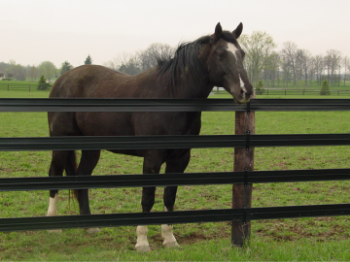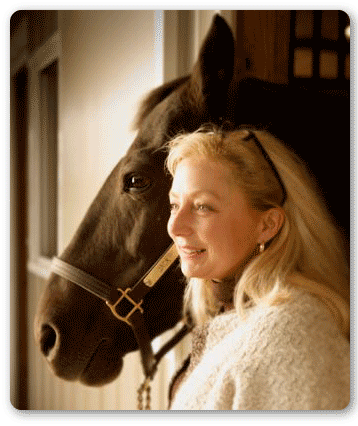Flexible Fencing is a Safer Alternative for Horses

If you're like me, you want the best for your wonderful horse. The care you give your equine friend might even be envied by some of your family members. This special bond is hard to explain, but nearly every true horse person shares it. We "crazy" horse people go the extra mile when it comes to our horses because we are passionate about them. Most horse owners love to find the best products for their horse or farm, and because we all lead busy lives, we like products that will give us more time with our horses and less time doing chores.
One product that is safer and cuts down on chore time is Flex Fence®.
You may have seen Flex Fence® but may not know how it works or why it lasts so long. Amazingly, 25 years ago, most people were not familiar with the concept of a flexible fence. Even more surprising is that today, many don't realize the benefits of this product. Flex Fence® is comprised of a high-tensile wire encased with polymer (plastic), which forms each rail. This flexible rail allows the fence to flex and then bounce back to its original shape. This type of fence was patented in Europe in 1957 and has made its way to the United States. Fences for horses need strength and durability. Until the flexible fence was introduced, there were not many fencing options that offered these features. A major benefit of these features is additional protection for your horses.
Our Flex Fence® rails come in an assortment of colors: white, black and brown, and will never have to be painted.
Rails come in a variety of sizes: 5.25", 4.25" and 3.75". We also offer 5/16" coated wire and 5/16" electric coated wire. These rail widths allow you to choose any combination of sizes to meet your horses' needs, as well as your budget. The rails are also "continuously run" which means the rails can stretch the entire length of the fence (660' and 330' or 1320' depending on your pasture layout) before you terminate or splice to finish your stretch of fence. Unlike boards that can break or get pulled away from the post, brackets allow the rail to move upon pressure. The force of a hit to a rail of the Flex Fence® will actually radiate the entire length of the fence line. This helps to eliminate any pressure points. Break strength varies with the type of rails you choose, but these rails have the break strength needed for horse containment. Typical warranties cover any manufacturer defects or problems due to weathering up to a limited lifetime manufacturer's warranty, but like most product warranties, will not cover damage due to abuse, accident or incorrect use.
For more secure containment, I suggest using electric fence with flexible rail.
No matter what type of fence system is used, I always recommend electric fence in conjunction with the rail. As horse owners, we need to be aware that it is our responsibility to keep our horses in a safer environment (but we all know our horses have minds of their own). Proper installation is important with any fence. Posts are the backbone of the fence system. They are just as important as the rails that you choose. Since flexible fences are tensioned, corners, end posts (including gate areas) and any posts out of a straight line need to be set in concrete. Manufacturer's instructions for setting posts are important, but are not difficult to follow. Pressure-treated pine posts work well due to their strength and ability to hold nails. End posts and brace posts are larger and longer than line posts. Check the recommended size of posts before you purchase.
Flexible tensioned fence systems are not all created equally.
Gauge of wire, thickness of the polymer and the quality of the hardware will vary from one manufacturer to another. We pride ourselves in offering high quality, pre-galvanized pre-straightened high tensile wires in all of our Flex Fence®. Our hardware is high-quality galvanized steel which is then pained for longevity. Finally, our unique tighteners are easy for one person to use! Be sure to select a tensioned fence system with is high quality, as any fence that is not installed or maintained properly can be a hazard to your horse.
Lastly, Flex Fence® systems are beautiful, while giving the appearance of an "estate" fence with much less maintenance.
The rail follows the flow of the land and is a beautiful complement to any farm or facility. Most of all, it is a safer alternative compared with traditional fence systems. Most people do not realize the flexible fence is not wood until they feel it. Of course, any fence that has not been maintained will not look the way it should, or do the job it needs to do. If you need to add to an existing fence or are considering a new fence, take a look at the flexible systems. These are very good horse containment fences, and I feel strongly that they will benefit you and your horse, now and in the future.
If you have questions on any topics on fencing, stalls or horses, please email us and I will do my best to respond personally or write an article covering your area of interest. I truly enjoy receiving your comments and appreciate the opportunity to share horse information.
 Debbie has over 45 years experience with horses and equine-related businesses. She has owned, trained, boarded horses and run stables at various times in her career. She is a certified fence installer, has given balanced riding lessons, and has shown horses in Western, Western Pleasure, Trail, English, Hunter/Jumper, Fox Hunting, Hunter Trials, Dressage and driving classes. Debbie has been involved in foaling, and just about every aspect of horse ownership possible.
Debbie has over 45 years experience with horses and equine-related businesses. She has owned, trained, boarded horses and run stables at various times in her career. She is a certified fence installer, has given balanced riding lessons, and has shown horses in Western, Western Pleasure, Trail, English, Hunter/Jumper, Fox Hunting, Hunter Trials, Dressage and driving classes. Debbie has been involved in foaling, and just about every aspect of horse ownership possible.
RAMM Fence Systems, Inc. makes every effort to provide reliable and useful information on horse health, care and products. The statements made on this website are based on years of experience with horses, however, they are based on generalized situations and should not replace diagnosis or treatment by a veterinarian or consultation by a professional. RAMM Fence Systems, Inc. does not assume any legal responsibility. Readers should always consult qualified health care providers for specific diagnosis and treatment.
